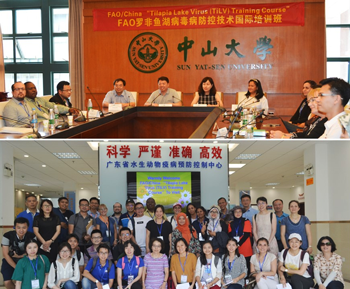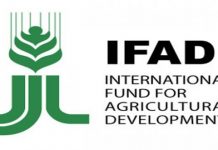[ad_1]
<!–
Table of materials and presentations
–>
 |
| Twenty nine participants representing competent authorities, academe and service providers completed the TILV 7-day intensive course from 18-24 June 2018. |
A collaborative capacity building initiative between China’s National Fisheries Extension Center and Sun Yat-Sen University and FAO, the TiLV course concluded successfully on 24 June 2018. Prof J He (SYSU) and Dr F Zang and Ms Q Li (NFTEC) were special guests during the opening and closing, respectively.
Some 29 participants (representing competent authorities, academe and service providers) from Brasil, China, Indonesia, Malaysia, Mozambique, Myanmar, Peru, Philippines, Sri Lanka and Viet Nam completed the course that was delivered by experts from China (Dr Y Hong, Prof A Li, Dr H Liu, Prof J Xia) and FAO (Dr K Tang/USA, Dr W Surachetpong/Thailand, Dr H Dong/VietNam, Dr M Jansen/Norway & Dr M Reantaso/FAO).
Seven sessions (consisting of 22 expert presentations, field visit, laboratory activities & interactive exercises) gave the participants the most current information on the biology, pathology, diagnostics, surveillance, farm level management of TiLV and emergency preparedness – and reinforced their capacity to prepare an action plan on TiLV.
Tilapias, the second-most important farmed finfish worldwide (with Nile Tilapia ranked 6th among the most important cultured species), are affordable, with widespread source of low cost but high quality protein and micronutrients. TiLV represents a serious threat to food security in countries where tilapias are farmed.
An enveloped, negative-sense, single stranded RNA virus, TiLV seems to have a narrow host specificity [farmed tilapia, e.g hybrid tilapia, Nile tilapia, red tilapia] and reported as well from several wild tilapines.
Histopathology, RT-PCR & RT-qPCR, and in-situ hybridization are recommended methods to identify TiLV; as well as fulfilling Koch’s postulate for first time diagnosis. Syncytial hepatitis is the most common histopathological lesion found in TiLV outbreaks,
Although the precise mechanism for transmission is unknown, horizontal disease transmission is likely to be the main mode of disease spread. Vertical transmission also needs to be investigated.
Fourteen tilapia producing countries had TiLV reports (e.g. through local and international scientific literature, OIE notifications). As live tilapia is widely traded, TiLV may have spread significantly over the years since the first report in 2009; no information on the role played by the trade in uncooked tilapia products.
Tilapia producing countries are encouraged to assess risks, undertake surveillance to determine national TiLV health status, investigate unexplained tilapia mortalities and introduce risk management measures where deemed necessary. The status of TiLV in a country can be politically sensitive; it is recommended that competent authorities are immediately informed of any observation (field or research) before such findings are made publicly available.
Further info can be obtained via email to: Melba.Reantaso@fao.org
[ad_2]
Source link





